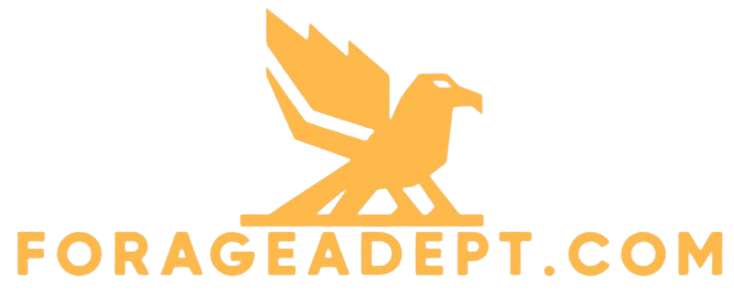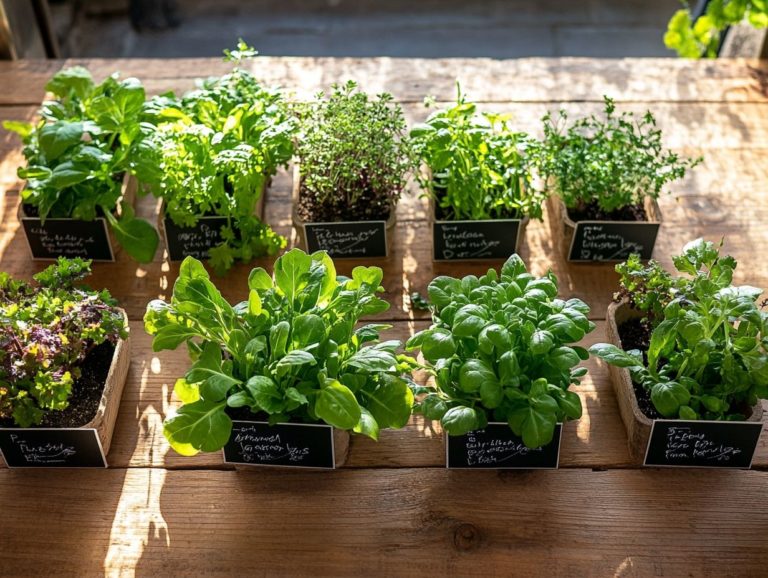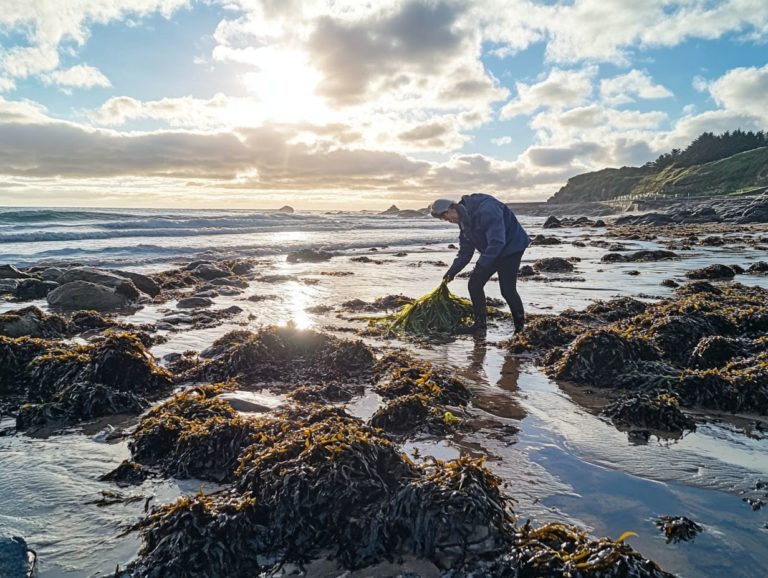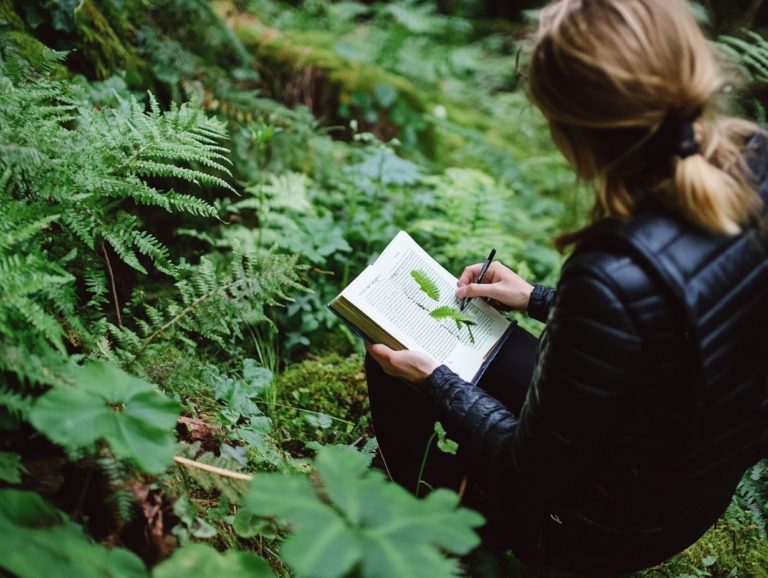How to Create a Foraging Journal
Foraging isn t just a hobby; it s a thrilling adventure in nature that immerses you in the outdoors and reveals many delicious plants waiting to be discovered.
This guide covers the essence and advantages of foraging, equipping you with essential tools to embark on this journey. You ll learn how to create and maintain a foraging journal, document your findings, and ensure your safety as you explore nature.
Whether you re a seasoned forager or a curious newcomer, this article provides the insights you need to enhance your foraging experiences.
Contents
Key Takeaways:
- Document your foraging experiences in a journal.
- Include important details like location, weather, and plant identification for accurate records.
- Prioritize safety by following precautions and using proper tools and gear when foraging.
What is Foraging?
Foraging is the art of seeking out and gathering wild foods, which includes a variety of edible plants found in the diverse ecosystems of North America. This time-honored practice invites you to connect deeply with nature while exploring culinary treasures hidden in local flora.
With guidance from experienced foragers like Ellen Zachos, you can elevate your skills with foraging tips that enhance your knowledge. The practice of seasonal foraging gathering plants at the right times of year can transform your skills into a refined craft that enhances your palate and appreciation for nature.
As you immerse yourself in this enchanting world, you ll discover safe-to-eat plants that not only enrich your diet but also promote sustainability and support biodiversity, which helps keep ecosystems healthy.
Definition and Benefits
Foraging involves intentionally gathering wild foods and edible plants that nature generously offers, bringing numerous benefits to you and the environment.
Engaging in this timeless practice elevates your diet with fresh, nutrient-rich ingredients while cultivating a deeper connection to the natural world. As you embark on this journey, you’ll find joy in learning from local experts and enhancing your understanding of food safety while exploring the diverse landscape of wild edibles.
Seasonal foraging is vital for maintaining ecological balance, promoting sustainable harvesting practices that honor the environment. By participating in foraging activities, you help preserve local biodiversity, fostering a harmonious relationship with nature that enriches both your well-being and the planet.
Getting Started with Foraging
Embarking on your foraging journey requires a carefully curated guide and essential tools to enhance your experience and ensure safety in the wild, especially during spring foraging trips.
Essential Tools and Gear
Essential tools and gear for your foraging adventures include a well-organized backpack, a reliable field guide, and items designed for plant identification, all aimed at enhancing your experience.
Additionally, keeping a notebook handy for recording your harvest logs can prove invaluable. This allows you to document your findings and track seasonal trends. Mobile plant identification apps are fantastic aids for distinguishing edible species from harmful look-alikes, giving you the confidence to explore without hesitation.
Safety gear, such as sturdy gloves and durable footwear, is crucial for ensuring a secure foraging expedition. When everything is organized neatly within your backpack, you can navigate your outings with ease, allowing you to focus on the joy of discovery and ultimately boosting your foraging success.
Creating a Foraging Journal
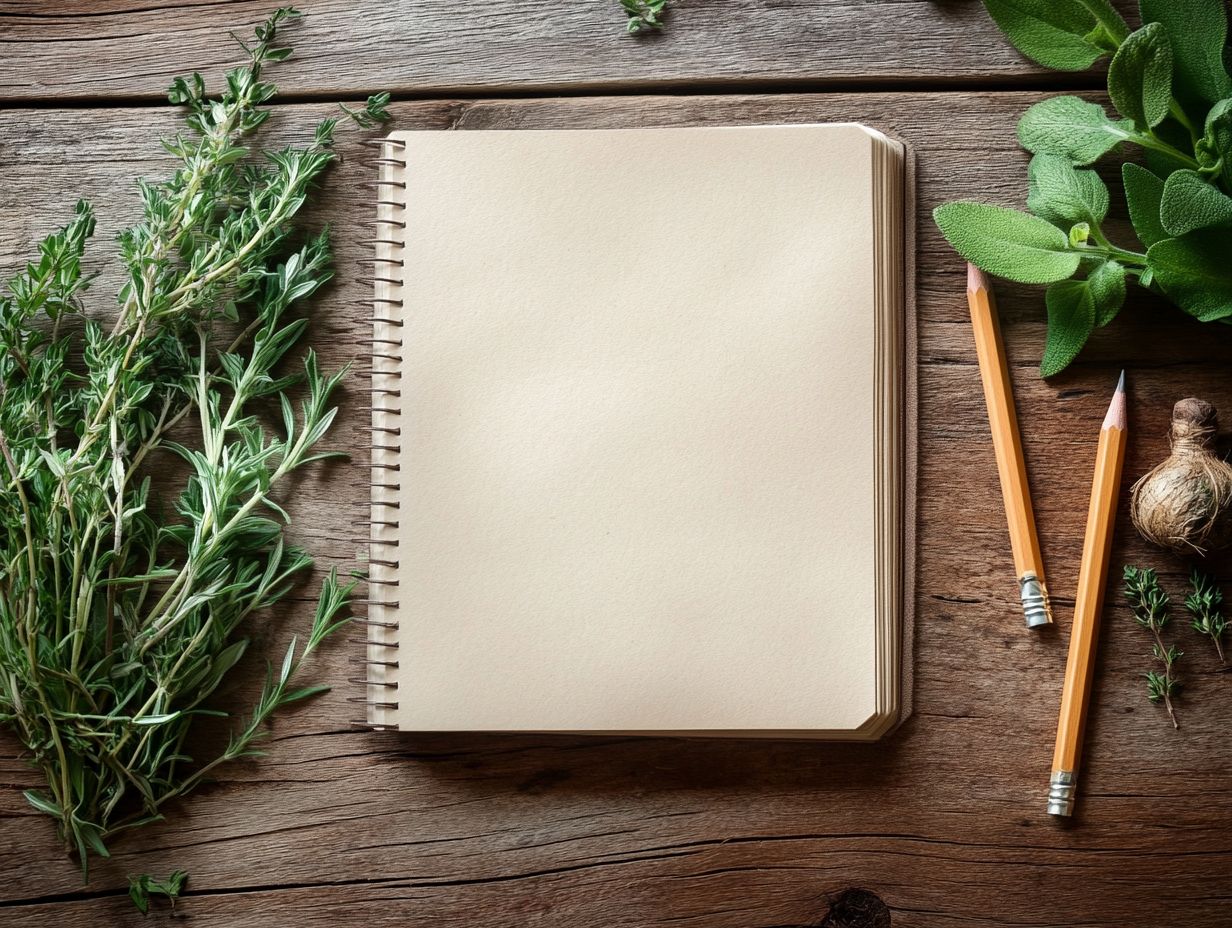
Creating a foraging journal is an essential practice for documenting your experiences. It serves as a comprehensive harvest log, a detailed guide for plant identification, and a space for you to reflect on your foraging adventures. For more insights, check out this guide on how to create a foraging journal.
Embrace this opportunity to capture the details of your journey in the natural world!
Why Keep a Foraging Journal?
A foraging journal offers many benefits. It helps you track your growth in foraging skills and learn how to document your foraging finds, allowing you to discover edible plants nearby.
This practice enables you to document your experiences and observations over time, encouraging deeper reflection on your outdoor adventures. By incorporating insights from your foraging trips like seasonal shifts in plant availability or the intricacies of local ecosystems you can enhance your understanding and appreciation of nature s bounty.
Each entry becomes a valuable record, helping you develop your skills as you learn to identify and utilize various wild edibles with increased confidence. The act of writing down your discoveries fosters a profound connection to nature, ultimately enriching your journey toward sustainable living and nurturing a lifelong passion for the outdoors.
What to Include in Your Journal
Your foraging journal should be a treasure trove of detailed entries capturing your unique experiences in the wild. Consider including how to document your foraging journey:
- Plant identification
- Notes on which plants are safe to eat
- Delightful recipes
- Sketches
- Insights on plant lookalikes
Don t underestimate the impact of weather conditions during your foraging excursions. Documenting them is essential, as they can greatly influence the growth and availability of specific plants.
Incorporating insights from local experts can elevate your understanding of the flora in your area. Be sure to note any personal interactions with seasoned foragers or classes you ve attended that broadened your knowledge.
And don t overlook the importance of food safety tips. Proper cleaning methods, handling techniques, and best practices for preserving your foraged finds are crucial. By taking this comprehensive approach, your journal will become an invaluable resource for all your future foraging adventures.
Recording Your Foraging Adventures
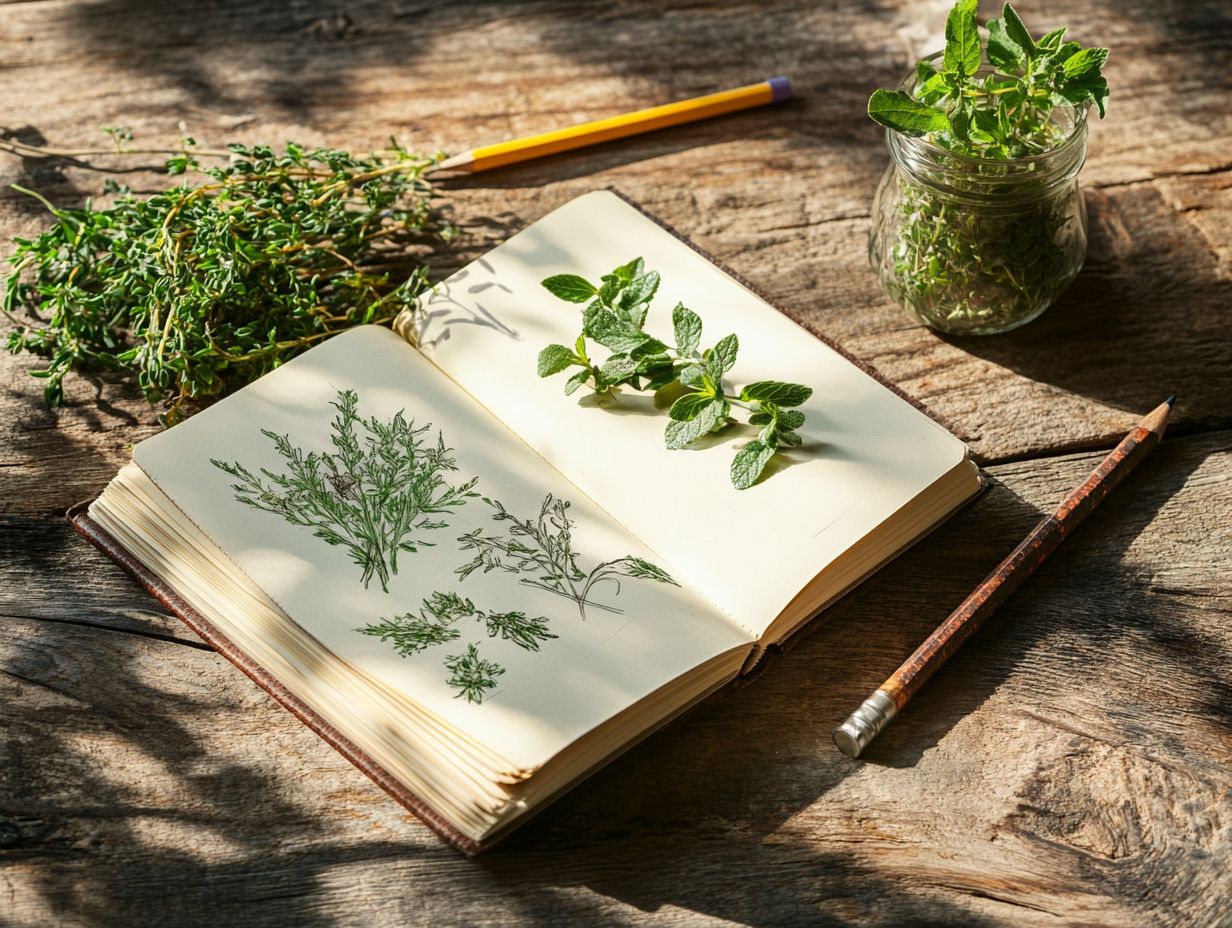
To accurately document your foraging adventures, it s essential to capture specific details. Take note of the types of wild foods you gather, their precise locations, and any other critical observations that may enrich your experience.
This meticulous approach enhances your understanding and elevates your foraging journey to a new level of engagement and appreciation.
Tips for Accurate and Detailed Entries
To create accurate and detailed entries in your foraging journal, document vital elements like the weather conditions and specific locations of your finds. Additionally, learning how to map your foraging routes can enhance your foraging experience.
Incorporating reliable field guides will elevate the credibility of your entries, allowing you to differentiate between similar species with ease. For an even richer journaling experience, cross-referencing your plant identifications with trusted sources and apps can help you avoid any mix-ups, ensuring that food safety remains a top priority.
Pay attention to the seasonality of each find, including when you harvested them; this context will prove invaluable for your future foraging adventures. Keep a record of any culinary experiments you embark on with your foraged ingredients and how they turned out. This not only charts your journey but also serves as a handy reminder of what delights work best in your kitchen!
Using Your Foraging Journal
Using your foraging journal effectively can greatly elevate your future foraging excursions. It allows you to reflect on past experiences and learn how to record and share your foraging experiences, crafting new adventures informed by the insights you’ve gathered along the way.
How to Use Your Journal for Future Foraging Trips
To make the most of your journal for future foraging trips, take some time to review past entries. Identify the successful strategies, locations, and recipes that truly made an impact.
By analyzing these records closely, you can uncover patterns in seasonal availability and environmental conditions that favor certain finds. Be sure to note the weather, terrain, and even the company you had during those successful outings. These factors can dramatically shape your experience.
Incorporating sketches or photographs can elevate your documentation process, providing visual cues for future reference. This ongoing assessment deepens your understanding of local ecosystems and hones your foraging skills.
Ultimately, having this well-organized body of knowledge significantly boosts your foraging success, making every new adventure even more rewarding.
Staying Safe while Foraging
Ensuring your safety while foraging is essential. It demands a solid understanding of safety precautions, effective plant identification techniques, and a keen awareness of poisonous varieties that could pose a threat.
When foraging, it s essential for you to implement important safety precautions, such as thoroughly identifying plants and consulting local experts. Pay special attention to food safety, particularly if you re pregnant.
These practices enhance your enjoyment of foraging and keep yourself safe as you engage in this fulfilling activity. It s crucial for you to build a strong understanding of the plants in your area; misidentifying them can pose serious health risks, including severe poisoning. Joining local foraging groups or attending workshops can provide you with invaluable insights that elevate your experience.
Remaining aware of your environment is vital steering clear of areas that may have been treated with pesticides is a must. Discovering safe plants transforms your foraging adventure! Knowing which plants are safe to eat and being able to differentiate them from their toxic counterparts can make all the difference in ensuring a safe and enjoyable foraging adventure.
Frequently Asked Questions
What is a foraging journal?
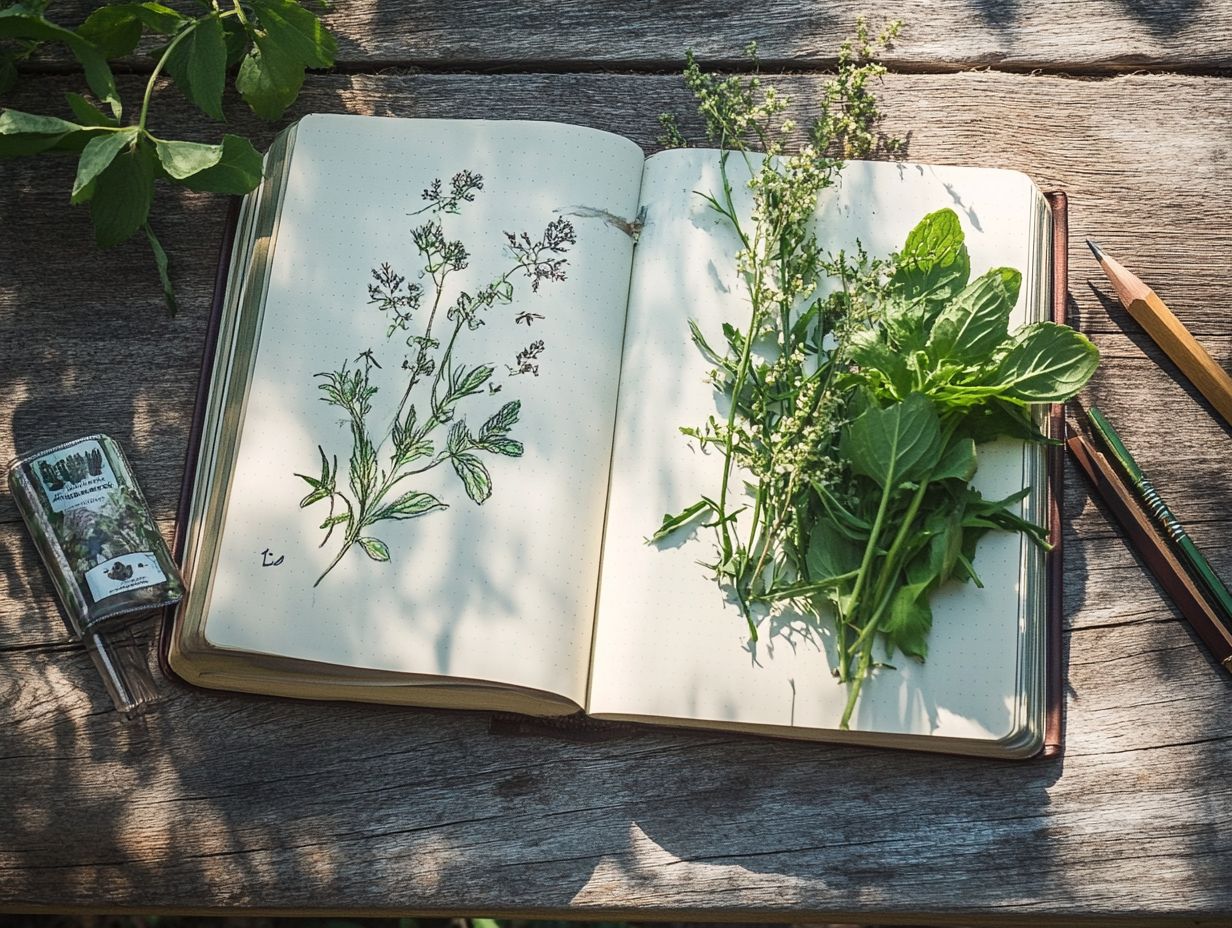
A foraging journal is a record-keeping tool used to keep track of what you find while foraging. It typically includes information on the location, date, time, and types of items found during a foraging excursion, as well as how to document your foraging adventures safely.
Why should I create a foraging journal?
Creating a foraging journal can help you organize and keep track of your foraging trips, as well as serve as a reference for future foraging endeavors. If you’re unsure where to start, check out this guide on how to create a foraging journal. It can also help you identify patterns and trends in your foraging habits.
How do I choose a format for my foraging journal?
There is no right or wrong format for a foraging journal. You can choose to use a physical notebook, a digital document, or even a mobile app. For those looking for guidance on how to keep track of their discoveries, learning how to document my foraging finds can be helpful. It is important to choose a format that is convenient and easy for you to access and update.
What information should I include in my foraging journal?
Some key information to include in your foraging journal are the location, date, time, weather conditions, types of items found, and any notes or observations you have about your foraging experience. Additionally, you can explore how to document your foraging experiences by including photographs or drawings to visually document your findings.
How often should I update my foraging journal?
It is recommended to update your foraging journal after each foraging trip to ensure accuracy and completeness. For more tips, learn how to document foraging locations effectively. However, you can also update it at a frequency that works best for you, such as once a week or once a month.
Yes, you can choose to share your foraging journal with others if you wish. This can be a great way to exchange tips and knowledge with fellow foragers or to simply document and share your foraging experiences with others.
Don’t wait start your foraging journal today! Consider joining local groups or workshops to enhance your foraging knowledge.
